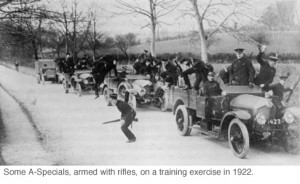‘Taking Matters into their own hands’ – The Ulster Special Constabulary
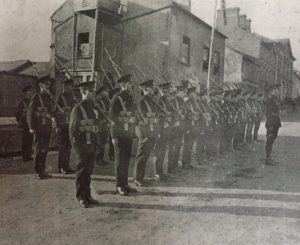
By John Ó Néill
The recent controversy over a planned state commemoration of the Royal Irish Constabulary (RIC) showed a fairly loose understanding of the RIC during the period from 1919 to 1922. Nor was it clear what the proposed commemoration signified.
One of the few signposts to the footprint of the commemoration is the figure for RIC casualties, 549, referenced by the Minister for Justice[1].
This would only appear to make sense if it includes losses from the ‘Black and Tans’, Auxiliary Division and the Ulster Special Constabulary. Yet this last group has been almost entirely omitted from the public debate thus far.
Who were the Ulster Special Constables?
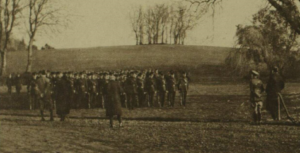
The Special Constabulary (after 1922 generally known as the ‘Ulster Special Constabulary’) were individuals sworn in as temporary RIC constables in different parts of Ireland. Leading unionists got sanction from the British cabinet for a scheme involving a massive intake of special constables to serve directly with the RIC.
Although it was denied at first, the scheme was only ever put into operation in the six counties that became part of Northern Ireland and sought to recruit directly from unionist organisation such as the Ulster Volunteers, Orange Order and Imperial Guards.
The Ulster Special Constabulary were individuals sworn in as temporary RIC constables from 1920 at the instigation of leading unionists with sanction from the British cabinet.
The rapid increase in recruitment of RIC Special Constables was announced on 22nd October 1920 but, like the ‘Black and Tans’, there was little pretence of offering any significant training in policing before deployment. The Special Constabulary was placed under the command of Lieutenant Colonel Charles G. Wickham of the RIC in Belfast.
Special Constables were recruited in three Classes (A, B and C) and were only to serve in their own locality. ‘A Class’ Special Constables were to serve as full-time RIC officers, wore RIC uniforms and were armed.
An RIC memoir published in the Sunday Independent over January and February 1934 referred to them as ‘barracks reinforcements’. They lived in the barracks with the RIC and were recruited on six months contracts. After two weeks at the RIC depot in Newtownards, the first ‘platoons’ went into service on 8 December 1920.
Over 20,000 Special Constables in A B and C classes were recruited and armed by the authorities in the North between 1920 and 1922.
‘B Class’ Special Constables were also only to serve on a part-time basis. They wore a cap and armlet (later an RIC uniform dyed dark green) and had the legal right to be armed and to keep arms at home. They were unpaid but received expenses.
‘C Class’ Special Constables were effectively the same as B Class but were over forty-five years of age and only to be called upon in an emergency. But they also had the legal right to keep arms.
By July 1921 3,500 A Class and 16,000 B Class Specials had been recruited. The proposed limits on recruitment (in mid-July 1922) were 8,000 A Specials and 25,000 B Specials. While the number of C Specials was theoretically unlimited, from 1921 a ‘C1 Class’ was recruited (5,000) and there was also a proposed C2/C3 Class (10,000 combined).
The C1/C2/C3 Classes were to be organised into battalions with a military command structure and were to be deployed as infantry in the field rather than attached to police divisions[2].
Previous Special Constables

Special constables were not an innovation of the War of the Independence in Ireland. A Special Constables (Ireland) Act had been passed in 1832 to permit their recruitment by magistrates during emergencies.
A special constable was sworn in by a magistrate for a defined period of time, wore an identifying badge or armlet, and carried out some policing duties.
While nominally the role was often described as guarding public buildings or the homes of prominent individuals, in reality being sworn-in provided a legal pretext to carry a weapon and a certain level of immunity from prosecution when special constables were deployed to physically oppose industrial protests or political agitation. An updated Special Constables Act had been passed as recently as 1914.
In the nineteenth century recruitment of special constables in Ireland occurred during elections as well as periods of political unrest, such as the rebellions of 1848 and 1867. In Britain they had been sworn in for a few days at a time as extra muscle during agitation for political change or industrial action, such as the railway and general strike in 1911.
A Special Constables (Ireland) Act had been passed in 1832 to permit their recruitment by magistrates during emergencies
Unions, such as the Transport Union, also had their own ‘Trade Unions Constables Club’ to protect industrial actions[3]. In 1911 and 1912, Orange Lodges called for their members to be sworn in as ‘special constables’ to serve Edward Carson’s proposed Provisional Government of Ulster that would oppose Home Rule.
The Dublin Metropolitan Police too recruited special constables during the suffragette campaign and during the Lockout in 1913. The general strike in Belfast early in 1919 saw calls for as many as 30,000 special constables to be sworn in.
So, the broader concept of swearing in special constables on an ad hoc basis for a specific, time-limited, purpose was well established by 1919 and the outbreak of the War of Independence.
Special Constables in the War of Independence
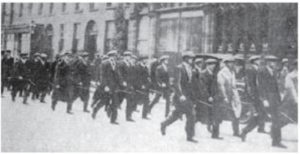
On 15 December 1919 the Irish Independent reported a rumour that Dublin Castle had “…invited, by circular, Irish Civil Servants to volunteer for work as special constables, to assist members of the DMP and RIC”.
By 19 December, the Evening Echo was reporting that fifty had been recruited in Dublin. This coincided with changes in the RIC leadership and the start of recruitment to the RIC from Britain in January 1920[4].
Special constable provisions were also clearly being used on an ad hoc basis elsewhere (under the 1832 Act). The Evening Herald, 16 September 1920, reported that a ‘special constable’ had been shot in the stomach in Dundalk. An ex-RIC man called Hannon kidnapped in Kings County was also described as a ‘special constable’ in the Freemans Journal on 23 July 1920.
Ad hoc Special Constables were used elsewhere in Ireland in 1920 to aid the RIC but the system was regularised and expanded in Ulster.
The creation of a more regularised Special Constabulary for Ulster only was being mooted that same day by General Henry Tudor (police advisor to Dublin Castle), Winston Churchill and unionist leader Sir James Craig.
This was also being lobbied for by Sir Basil Brooke, a Fermanagh landowner and Wilfred Spender, head of the Ulster Volunteer Force or UVF – the militia raised by unionists to oppose Home Rule in 1912.[5]
‘Sowing dragon’s teeth’ – The formation of the Ulster Specials
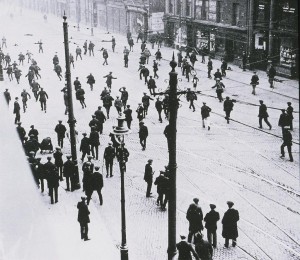
Two days earlier thousands of Catholics in Belfast had been forced from their places of work, like the shipyards, in what contemporary commentators described as a ‘pogrom’.
The Craig proposal came in the immediate wake of revivals of the UVF in a number of locations earlier in 1920. At the Twelfth of July demonstrations that summer, Sir Edward Carson had announced that if the British government didn’t accept the assistance of a reorganised UVF, they would ‘take matters into their own hands’. The next day the London Times was scathing:
“If indeed that organisation was revived as a defensive police force for Ulster the most serious consequences would almost certainly ensue. Upon Sir Edward Carson lies largely the blame for having sown the dragon’s teeth in Ireland.”[6]
Unionist leader Carson called for the ‘a defensive police force’, to prevent loyalist organisations such as the UVF, ‘taking matters into their own hands’.
While Craig, Brooke and Spender’s proposals were rejected, some magistrates and local authorities swore in special constables regardless including the Belfast shipyard workers that had expelled their Catholic colleagues. The Evening Herald was soon to report that three special constables, wearing official armlets and carrying batons, had been arrested in Belfast for looting.[7]
Lisburn was a local council that went ahead and recruited special constables, citing the legal basis as the Special Constables (Ireland) Act 1832.
The previous week RIC District Inspector Oswald Swanzy, believed to be one of those responsible for killing Cork Mayor Tomás MacCurtain, had been shot dead by the IRA in Lisburn. Catholic residents and businesses were systematically burned out of the town over the following days (more sporadic burning and looting had already happened the previous month).
By mid-October some 30 of the 300 special constables in Lisburn had been either convicted of, or charged with, participating in the burning out of the Catholics in the town. Some more individuals charged with violent offences in Belfast were also identified as special constables in court.
Sir James Craig re-submitted his proposals to the cabinet, as ‘Suggested steps for government action’ on 28 August with a scheme to recruit special constables in the north that would explicitly include “a system of organised reprisals”.[8]
Despite largely being the protagonists in disturbances in Belfast, Derry and Lisburn, Craig claimed that the ‘loyal population’ were having to threaten to resort to arming themselves as the government were not protecting them.
On 8 September the British government agreed to appoint an under-secretary from Dublin Castle who would be based in Belfast and oversee the role of 2,000 special constables that would be recruited into service for periods such as six months rather than a few days.
Both General Macready and Sir Henry Wilson believed this was an error, and felt that these units should be explicitly placed under military control. The Irish Office in London insisted that new ‘Special Constabulary’ units would not just be raised in Ulster counties.
By the time the decision to expand the use of special constables was made public on 22 October 1920, more charges had been brought against Belfast and Lisburn special constables over the August violence, leading to a special constable mutiny in Lisburn.
All charges and convictions against them were then struck out or dropped. Formal recruitment for the new intake of special constables began on 1 November 1920, starting in the Belfast and Tyrone policing districts with other counties following soon after. However, throughout October, the press had been reporting that Orange Lodges had already been enrolling members for the new call for special constables.
Regularising the Ulster Special Constables.
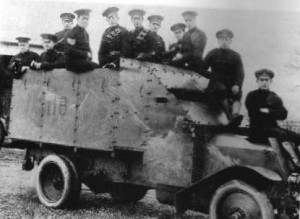
It was at this point that the Special Constabulary was rationalised in to A, B and C classes and formal arming, training and uniforms provided.
Publicly, at least, it was maintained that the roll out of Craig’s new ‘Special Constables’ scheme was not to be confined to the north-east although it was unambiguously to support the RIC in opposing the forces pursuing Irish independence.
In the House of Commons at Westminster, on 11 November 1920, Sir Hamar Greenwood (the Chief Secretary for Ireland) stated that he had the power to “…appoint special constables to each county in turn…” and was merely doing it in those counties that needed it most first.[9]
In theory Special Constables could be raised in any county in Ireland, but in reality the scheme was confined to the six counties that would go on to form Northern Ireland.
Even when it became clear that the new scheme would only apply to counties Antrim, Armagh, Derry, Down, Fermanagh and Tyrone, official statements continued to use the name ‘Special Constabulary’. The press largely ignored the fiction being maintained by Greenwood and Dublin Castle and began to use the term ‘Ulster Special Constabulary’.
While clearly the Special Constabulary drew on the Ulster Volunteers, there were some Catholic members, although there were immediate claims that they were subject to intimidation. One Catholic recruit, John Melaugh, was approached by two men, asked his religion, then shot while on weekend leave after his first week of training in Newtownards.
When the first two platoons of Special Constables passed through Newtownards in December they were immediately posted to RIC stations for duty. But within weeks Special Constabulary platoons in Newtownbutler and Newry were suspended after the members from Newtownbutler members were arrested by the RIC. A gun battle had erupted when the RIC had interrupted them looting and raiding houses and business in Clones.
Members of the Newry platoon were charged with assault and robbery. Both platoons were recalled to Newtownards for ‘retraining’.
On deployment
The involvement of Special Constables in the north during 1921-22 is documented in detail in various books and accounts in the Military Archives in Dublin.[10]
Belfast, where the truce was simply ignored in July 1921, was the most intense theatre of the conflict in the north in 1919-1922.
In June 1921 Sir James Craig, who had advocated a ‘system of reprisals’, had become Prime Minister of Northern Ireland with Wilfred Spender as Cabinet secretary and Basil Brooke, from 1922, as Commandant of the Special Constabulary.
Belfast alone accounted for 20-25% of all violent fatalities in Ireland during the War of Independence and the Specials were widely accused of indiscriminate violence against the Catholic population.
From the formation of Dáil Éireann until the outbreak of the civil war in mid-1922 Belfast alone accounted for 20-25% of all violent fatalities in Ireland. Sympathetic RIC men passed detailed information to the IRA on the role played by RIC officers and Special Constables in a range of violent activities – opening fire on Catholic districts, operating ‘murder gangs’ and participating in mass killings.
In Weaver Street in Belfast in February 1922, a Special Constable first herded children together before a bomb was thrown into their midst by one of two men who had been accompanied by three RIC and Special Constables. Six women and children died in the attack and many others were badly injured. The men also opened fire on people coming to the aid of the injured.
Outside Belfast special constables were implicated in other killings and attacks such as the burning of ten houses, including a priest’s house in Roslea and the burning of 161 houses and deaths of ten Catholics in Newry.[11] Victims of violence included women and children killed at close quarters, in some cases where the RIC and Special Constables were implicated by eye-witnesses.
Special Constables were also alleged to be involved in the brutal gang rape of a woman that preceded the Altnaveigh massacre of June 1922 in which the IRA killed six Protestants in south Down in revenge.[12]
On one occasion there was controversy over the treatment of Catholic primate Cardinal Logue when he was detained by Special Constables.

The UK police’s roll of honour lists 73 Special Constables killed between 1920 and 1922 although this listing appears incomplete.[13] The first Special Constable to be killed on duty was Wiliam Compston who was shot dead in Cullyhanna in Armagh on 13th January 1921.
Among notable incidents were three Special Constables who were shot in an ambush at Fivemiletown on 29 June 1921 and four Special Constables killed in a shoot-out known as the ‘Clones Affray’, at the train station in Clones in February 1922.[14] The Police Roll of Honour records suggest that most Special Constabulary fatalities occurred on duty.
Craig’s vision of a ‘system or organised reprisals’ by a Special Constabulary was very much realised during the period from 1920 until the late summer of 1922.
That said, reprisal killings by the RIC had been happening in Belfast before Craig’s scheme was put in place (such as Ned Trodden, Sean Gaynor and Sean McFadden, abducted and killed by the RIC on 26 September 1920).
Men served in their home districts, as did the IRA, giving the violence an added intimacy. This has a lasting legacy as the Special Constable would remain living in the community after 1921-1922 possibly continuing as a Special Constable or in some other position of authority. These factors were peculiar to Special Constables in the north as RIC personnel were typically posted outside their home district and indeed many of the new recruits in 1920-1921 came from outside Ireland.
The IRA appear to have suffered relatively few direct fatal casualties at the hands of the Special Constabulary, either in Belfast or in other northern counties, but a far greater number were imprisoned or forced into exile in the south. A useful point to explore in future, would be the extent to which Craig, Brooke, Spender and others had a clear methodological framework in which they were intentionally deploying violence.[15]
In any case, the Belfast IRA remained operational until June 1922 when it was degraded
by the disruption caused by the Civil War in the south.
The Special Constabulary after 1922

While their supporters attempted to present the stereotypical Special Constable as reserved, religious and loyal, these tropes are not matched by the frequent prosecutions for petty theft, drunkenness and other criminal offences, as well as often deadly reprisals against civilians.
When the Royal Ulster Constabulary (RUC) formally succeeded the RIC in the north on 1 June 1922 the Special Constabulary was retained. In part because the RUC’s numbers were limited to 3,000 men.
However the cost of maintaining the Special Constabulary was to become problematic. Public debates over the disbanding of the Special Constabulary dragged on until 1925 as London was continuing to pay £1.4m per year to maintain the force including the 6,000 strong C1 Class military unit.[16]
The A and C classes of Specials were disbanded in 1925 leaving only the part time B Specials, who continued until 1970.
Once the boundary commission legislation was passed in Westminster, solidifying the border, it was agreed that the funding for the Special Constabulary was to cease after a final grant of £1.2m. It was then re-organised, effectively leaving only the B Class who were afterwards simply known as the B Specials.
There was a crisis for a number of days following that announcement in December 1925 as the A Specials threatened to mutiny, but it swiftly passed and re-organisation went ahead leaving only the B-Specials. The B Specials continued until it was stood down in 1970 as part of the Hunt Committee Report’s recommendations following its role in the violence of 1968 and 1969.
A quirk in the historiography of the revolutionary era in Ireland is that there has been no substantive attempt to capture oral or written histories of the Special Constabulary, or indeed other units of the RIC.
Ironically the best documented, in terms of memoirs and witness statements, are actually the clandestine and proscribed organisations like the IRA, Fianna Éireann and Cumann na mBan. This might not have been the case, though. In 1937 former Special Constables demanded access to a process similar to that undertaken for the IRA and other republican organisations as part of the Military Pensions Act. Unfortunately, the opportunity was missed.
The Special Constables recruited to serve with the RIC under Sir James Craig’s scheme were, in their application of Dublin Castle’s policing strategies, very much a mirror image of the ‘Black and Tans’ and other RIC units. However, as locals, their relationship to the district in which they operated was significantly different and gave their impact and legacy dimensions that were not present outside the northern counties.
John Ó Néill’s PhD is in archaeology but he mostly writes about history these days. He has started up a small publisher, LitterPress (see www.litter.press) intending it to become less small and often blogs at www.treasonfelony.com.
References
[1] See http://www.justice.ie/en/JELR/Pages/PR20000003; the figures quoted even appear to exceed Richard Abbot’s book ‘Police Causalities in Ireland, 1919-1922’ (Mercier Press) making it seem highly unlikely that any of the Black and Tans, Auxies or Specials were not included.
[2] See Ellison and Smyth’s The Crowned Harp (Pluto Press), p26-27 and Hezlett’s The ‘B’ Specials: A History of the Ulster Special Constabulary (Pan), p88.
The ‘B’ Specials: A History of the Ulster Special Constabulary, London: Pan Books.
[3] The Transport Union made a call to enrol its own Special Constables in January 1912. This was following on from further calls made by prominent Unionists to enrol their own Special Constables to resist Home Rule (eg see Irish Independent 20 January 1912).
[4] see https://www.theirishstory.com/2020/01/13/the-black-and-tans-and-auxiliaries-an-overview/comment-page-1/#comment-60434
[5] Brooke and Sender’s lobbying is described in Pearse Lawlor’s 1920-22: The Outrages (Mercier Press).
[6] Quoted in G.B. Kenna 1922 Facts and Figures of the Belfast Pogrom 1920-22, p52. The press reported such resolutions from Orange Lodges such as Lecale in County Down in The Anglo-Celt on 21 October 1911
[7] Evening Herald, 28 August 1920
[8] PRONI, CAB/5/1
[9] See Hansard, 11 November 1920 (http://bit.ly/2NwkYpT)
[10] For instance Facts and Figures of the Belfast Pogrom 1920-22, Kieran Glennon’s From Pogrom to Civil War and Pearse Lawlor’s The Outrages, 1920-1922 (both Mercier Press).
[11] For more details see Lawlor, ibid.
[12] There are specific references to Special Constables ‘brow-beating’ women during raids in Belfast and targeted killings of women in Facts and Figures of the Belfast Pogrom, 1920-22 (the bomb attack in Weaver Street on 13 February 1922 being a particularly brutal example). Attacks against women, including a woman being set fire to in her home, women having their hair cut off and other violent incidents are known from Belfast but, as far as I know, have yet to be systematically documented. Women make up about 1 in 7 of those killed in Belfast from 1920 to 1922. The gang rape that preceded the Altnaveigh massacre is covered by Robert Lynch (‘Explaining the Altnaveigh Massacre, June 1922’ in Éire-Ireland, 45, 3-4).
[13] See http://www.policememorial.org.uk/rollofhonour.php although this includes individuals killed in accidents, at least 47 appear to have been killed by the IRA. Some individuals can be identified in fatality records who are not listed – e.g., Charles Vokes who was shot dead by the military after an altercation in Belfast on 12 March 1922 was an A Class Special Constable.
[14] For the ‘Clones Affray’ see: https://www.historyireland.com/20th-century-contemporary-history/the-clones-affray-1922-massacre-or-invasion/
[15] It may be notable here that Craig saw military service in South Africa during the Boer War (Kitchener was an ardent advocate of deploying ‘native’ forces in pacification campaigns). The involvement of locals in counter-insurgency operations was tried in South Africa and was to be a recurring theme – it is the basis of the French jaunissement strategy in Indochina. This was echoed in Nixon’s Vietnamization policy and returned to Ireland, in 1974, as ‘Ulsterisation’.
[16] See Belfast Newsletter, 1 April 1925
